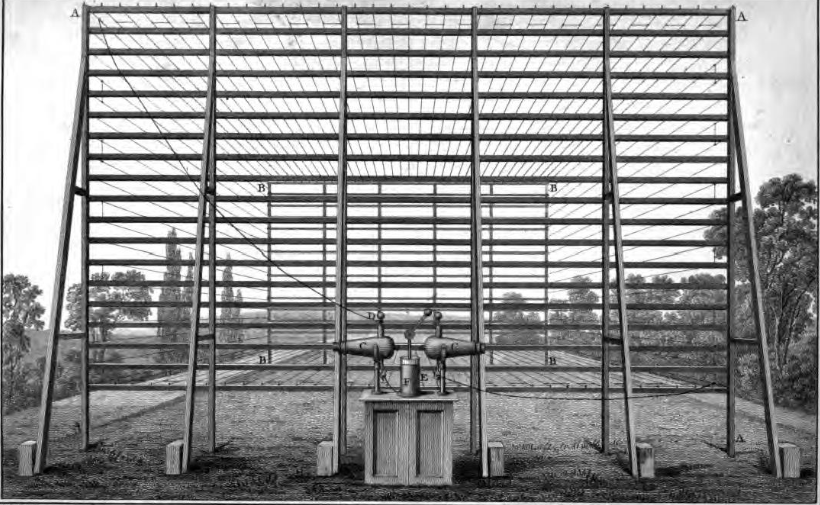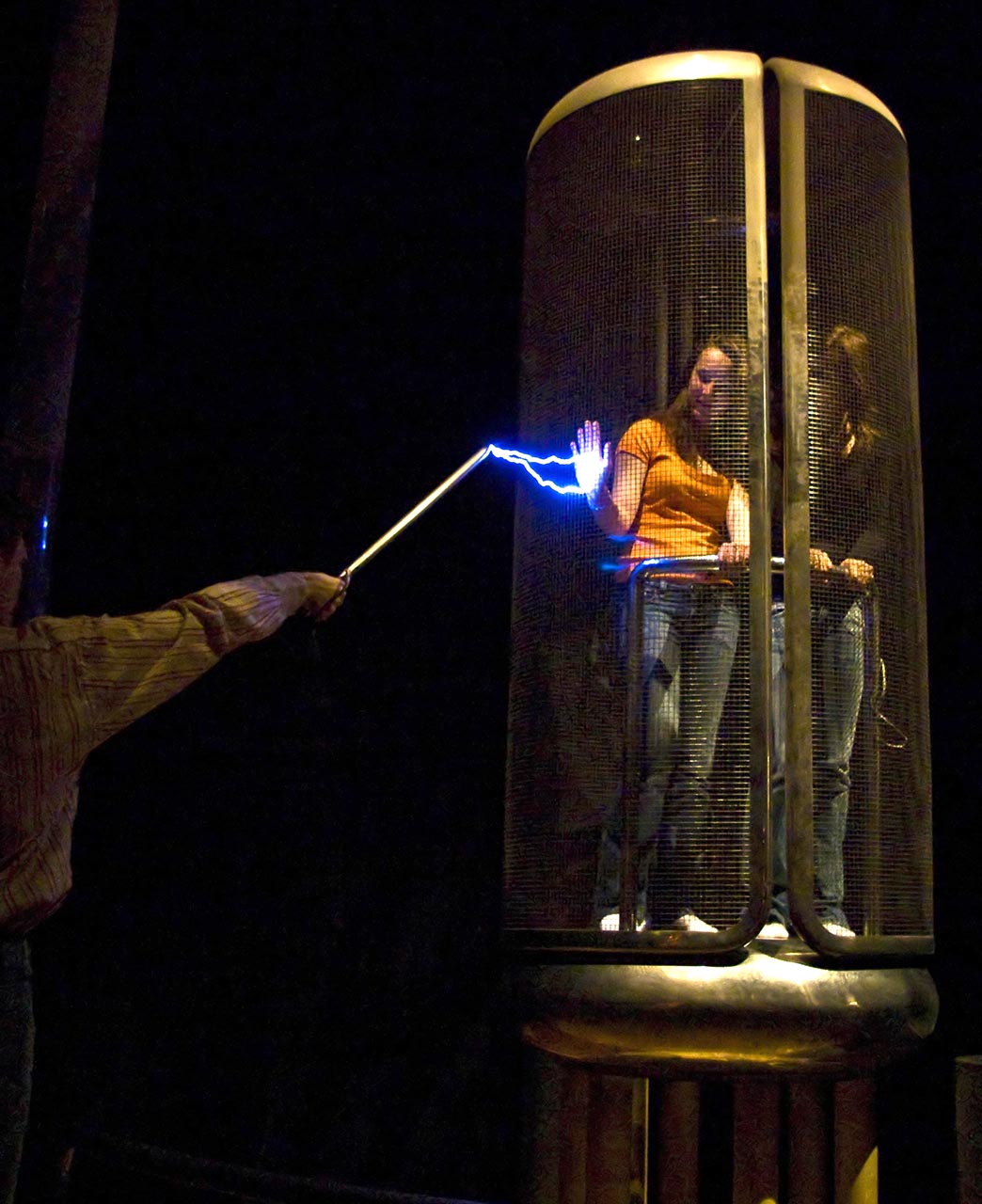|
Electrometer
An electrometer is an electrical instrument for measuring electric charge or electrical potential difference. There are many different types, ranging from historical handmade mechanical instruments to high-precision electronic devices. Modern electrometers based on vacuum tube or solid-state technology can be used to make voltage and charge measurements with very low leakage currents, down to 1 femtoampere. A simpler but related instrument, the electroscope, works on similar principles but only indicates the relative magnitudes of voltages or charges. Historical electrometers Gold-leaf electroscope The gold-leaf electroscope was one of the instruments used to indicate electric charge. It is still used for science demonstrations but has been superseded in most applications by electronic measuring instruments. The instrument consists of two thin leaves of gold foil suspended from an electrode. When the electrode is charged by induction or by contact, the leaves acquire simi ... [...More Info...] [...Related Items...] OR: [Wikipedia] [Google] [Baidu] |
Francis Ronalds
Sir Francis Ronalds FRS (21 February 17888 August 1873) was an English scientist and inventor, and arguably the first electrical engineer. He was knighted for creating the first working electric telegraph over a substantial distance. In 1816 he laid an eight-mile length of iron wire between wooden frames in his mother's garden and sent pulses using electrostatic generators. Upbringing and family Born to Francis Ronalds and Jane (née Field), wholesale cheesemongers, at their business premises in Upper Thames Street, London, he attended Unitarian minister Eliezer Cogan's school before being apprenticed to his father at the age of 14 through the Drapers' Company. He ran the large business for some years. The family later resided in Canonbury Place and Highbury Terrace, both in Islington, at Kelmscott House in Hammersmith, Queen Square in Bloomsbury, at Croydon, and on Chiswick Lane. Several of Ronalds' eleven brothers and sisters also led noteworthy lives. His younges ... [...More Info...] [...Related Items...] OR: [Wikipedia] [Google] [Baidu] |
Kearny Fallout Meter
The Kearny fallout meter, or KFM, is an expedient radiation meter. It is designed such that someone with a normal mechanical ability would be able to construct it before or during a nuclear attack, using common household items. The Kearny fallout meter was developed by Cresson Kearny from research performed at Oak Ridge National Laboratory and published in the civil defense manual ''Nuclear War Survival Skills'' (). The plans were originally released in Oak Ridge National Laboratory publication ORNL-5040, ''The KFM, A Homemade Yet Accurate and Dependable Fallout Meter'' and have been formatted in a newsprint-ready layout so that they may be quickly printed with accurate dimensions in local newspapers. It must be built from a correctly scaled copy of the plans; photocopies and printouts of digital copies may not be to scale. History Devised in 1978 by Cresson Kearny, the Kearny fallout meter is an application of the gold-leaf electroscope developed in 1787 by Abraham Bennet. Pri ... [...More Info...] [...Related Items...] OR: [Wikipedia] [Google] [Baidu] |
Johann Gottlieb Friedrich Von Bohnenberger
Johann Gottlieb Friedrich von Bohnenberger (5 June 1765 – 19 April 1831) was a German astronomer born at Simmozheim, Württemberg. He studied at the University of Tübingen. In 1798, he was appointed professor of mathematics and astronomy at the University. He published: * ''Anleitung zur geographischen Ortsbestimmung'' (Guide to geographic locations), 1795 * ''Astronomie'' (Astronomy), 1811 * ''Anfangsgründe der höhern Analysis'' (Initial reasons of higher analysis), 1812. In 1817, he systematically explained the design and use of a gyroscope apparatus which he called simply a “Machine.” Several examples of the 'Machine' were constructed by Johann Wilhelm Gottlob Buzengeiger of Tübingen. Johann Friedrich Benzenberg had already mentioned Bohnenberger's invention (describing it at length) in several letters beginning in 1810. Bohnenberger died at Tübingen. The lunar crater Bohnenberger is named after him. See also * Bohnenberger electrometer *Kater's ... [...More Info...] [...Related Items...] OR: [Wikipedia] [Google] [Baidu] |
Jean Charles Athanase Peltier
Jean Charles Athanase Peltier (; ; 22 February 1785 – 27 October 1845) was a French physicist. He was originally a watch dealer, but at the age of 30 began experiments and observations in physics. Peltier was the author of numerous papers in different departments of physics. His name is specially associated with the thermal effects at junctions in a voltaic circuit, the Peltier effect. Peltier introduced the concept of electrostatic induction (1840), based on the modification of the distribution of electric charge in a material under the influence of a second object closest to it and its own electrical charge. Biography Peltier trained as a watchmaker; until his 30s was a watch dealer. Peltier worked with Abraham Louis Breguet in Paris. Later, he worked with various experiments on electrodynamics and noticed that in an electronic element when current flows through, a temperature gradient or temperature difference is generated at a current flow. In 1836 he published his wor ... [...More Info...] [...Related Items...] OR: [Wikipedia] [Google] [Baidu] |
Kew Observatory
The King's Observatory (called for many years the Kew Observatory) is a Grade I listed building in Richmond, London. Now a private dwelling, it formerly housed an astronomical and terrestrial magnetic observatory founded by King George III. The architect was Sir William Chambers; his design of the King's Observatory influenced the architecture of two Irish observatories – Armagh Observatory and Dunsink Observatory near Dublin. Location The observatory and its grounds are located within the grounds of the Royal Mid-Surrey Golf Club, which is part of the Old Deer Park of the former Richmond Palace in Richmond, historically in Surrey and now in the London Borough of Richmond upon Thames. The former royal manor of Kew lies to the immediate north. The observatory grounds overlie to the south the site of the former Sheen Priory, the Carthusian monastery established by King Henry V in 1414. The observatory is not publicly accessible, and obscuring woodlands mean that it canno ... [...More Info...] [...Related Items...] OR: [Wikipedia] [Google] [Baidu] |
Ferdinand Braun
Karl Ferdinand Braun (; 6 June 1850 – 20 April 1918) was a German electrical engineer, inventor, physicist and Nobel laureate in physics. Braun contributed significantly to the development of radio and television technology: he shared the 1909 Nobel Prize in Physics with Guglielmo Marconi "for their contributions to the development of wireless telegraphy", was a founder of Telefunken, one of the pioneering communications and television companies, and has been both called the "father of television" (shared with inventors like Paul Gottlieb Nipkow) and the co-father of the radio telegraphy, together with Marconi. Biography Braun was born in Fulda, Germany, and educated at the University of Marburg and received a PhD from the University of Berlin in 1872. In 1874, he discovered that a point-contact metal–semiconductor junction rectifies alternating current. He became director of the Physical Institute and professor of physics at the University of Strassburg in 1895. In 189 ... [...More Info...] [...Related Items...] OR: [Wikipedia] [Google] [Baidu] |
William Snow Harris
Sir William Snow Harris (1 April 1791 – 22 January 1867) was a British physician and electrical researcher, nicknamed Thunder-and-Lightning Harris, and noted for his invention of a successful system of lightning conductors for ships. It took many years of campaigning, research and successful testing before the British Royal Navy changed to Harris's conductors from their previous less effective system. One of the successful test vessels was which survived lightning strikes unharmed on her famous voyage with Charles Darwin. Life and work Harris was born in Plymouth on 1 April 1791. His family was well established as solicitors in the town, and he went to Plymouth grammar school. His childhood in the seaport which included the naval dockyard renamed Devonport gave him an enduring interest in ships. He went to the University of Edinburgh to study medicine and qualified as a physician, then returned to Plymouth and set up a medical practice. His interest in the emerging scienc ... [...More Info...] [...Related Items...] OR: [Wikipedia] [Google] [Baidu] |
Zamboni Pile
The Zamboni pile (also referred to as a ''Duluc Dry Pile'') is an early electric battery, invented by Giuseppe Zamboni in 1812. A Zamboni pile is an "electrostatic battery" and is constructed from discs of silver foil, zinc foil, and paper. Alternatively, discs of "silver paper" (paper with a thin layer of zinc on one side) gilded on one side or silver paper smeared with manganese dioxide and honey might be used. Discs of approximately 20 mm diameter are assembled in stacks, which may be several thousand discs thick, and then either compressed in a glass tube with end caps or stacked between three glass rods with wooden end plates and insulated by dipping in molten sulfur or pitch. Zamboni piles of more modern construction were manufactured as recently as the 1980s for providing the accelerating voltage for image intensifier tubes, particularly in military use. Today such voltages are obtained from transistorised inverter circuits powered by conventional (low-voltage) batt ... [...More Info...] [...Related Items...] OR: [Wikipedia] [Google] [Baidu] |
Faraday Cage
A Faraday cage or Faraday shield is an enclosure used to block electromagnetic fields. A Faraday shield may be formed by a continuous covering of conductive material, or in the case of a Faraday cage, by a mesh of such materials. Faraday cages are named after scientist Michael Faraday, who invented them in 1836. A Faraday cage operates because an external electrical field causes the electric charges within the cage's conducting material to be distributed so that they cancel the field's effect in the cage's interior. This phenomenon is used to protect sensitive electronic equipment (for example RF receivers) from external radio frequency interference (RFI) often during testing or alignment of the device. They are also used to protect people and equipment against actual electric currents such as lightning strikes and electrostatic discharges, since the enclosing cage conducts current around the outside of the enclosed space and none passes through the interior. Faraday cages ... [...More Info...] [...Related Items...] OR: [Wikipedia] [Google] [Baidu] |
Coulomb Electrometer
The coulomb (symbol: C) is the unit of electric charge in the International System of Units (SI). In the present version of the SI it is equal to the electric charge delivered by a 1 ampere constant current in 1 second and to elementary charges, , (about ). Name and history By 1878, the British Association for the Advancement of Science had defined the volt, ohm, and farad, but not the coulomb. In 1881, the International Electrical Congress, now the International Electrotechnical Commission (IEC), approved the volt as the unit for electromotive force, the ampere as the unit for electric current, and the coulomb as the unit of electric charge. At that time, the volt was defined as the potential difference .e., what is nowadays called the "voltage (difference)"across a conductor when a current of one ampere dissipates one watt of power. The coulomb (later "absolute coulomb" or "abcoulomb" for disambiguation) was part of the EMU system of units. The "international coulomb" ... [...More Info...] [...Related Items...] OR: [Wikipedia] [Google] [Baidu] |
Early Quadrant Electrometer
{{disambiguation, geo ...
Early may refer to: History * The beginning or oldest part of a defined historical period, as opposed to middle or late periods, e.g.: ** Early Christianity ** Early modern Europe Places in the United States * Early, Iowa * Early, Texas * Early Branch, a stream in Missouri * Early County, Georgia Other uses * ''Early'' (Scritti Politti album), 2005 * ''Early'' (A Certain Ratio album), 2002 * Early (name) * Early effect, an effect in transistor physics * Early Records, a record label * the early part of the morning See also * Earley (other) Earley is a town in England. Earley may also refer to: * Earley (surname), a list of people with the surname Earley * Earley (given name), a variant of the given name Earlene * Earley Lake, a lake in Minnesota *Earley parser, an algorithm *Earley ... [...More Info...] [...Related Items...] OR: [Wikipedia] [Google] [Baidu] |







